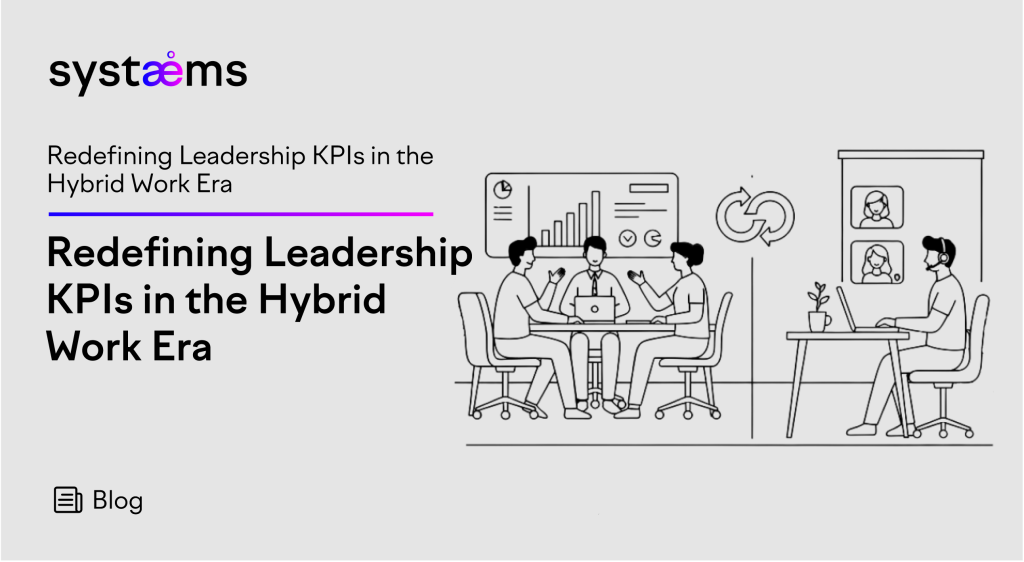Building a Performance-Driven Culture with KPIs and Data Insights
Empower teams with KPIs and data insights to foster accountability, agility, and sustainable growth.

Leadership has always been about results. Traditionally, KPIs (Key Performance Indicators) for leaders revolved around financial outcomes, operational efficiency, and strategic delivery. But the global shift to hybrid work has dramatically changed what leadership looks like and how success must be measured.
Hybrid work environments blur the lines between physical and digital workplaces, requiring leaders to navigate not only business outcomes but also employee experience, trust, collaboration, and adaptability. Old KPIs that focused on output alone are no longer sufficient. Leaders today must balance performance with empathy, culture with accountability, and innovation with stability.
At Systaems, we help organizations redefine leadership KPIs to match this evolving workplace reality. By combining performance management systems, data-driven insights, and governance frameworks, we ensure leaders are evaluated in ways that reflect both results and resilience.
Before the hybrid era, leadership KPIs were often limited to:
While these remain important, they only tell part of the story. In hybrid models, leaders must manage diverse challenges:
If leaders are still evaluated by outdated KPIs, organizations risk undervaluing critical skills like empathy, adaptability, and inclusivity.
When Systaems partnered with Felda Global Ventures Plantations, the organization needed a new performance management framework. Traditional leadership KPIs were focused on operational efficiency and output, but they didn’t capture sustainability, governance, or employee well-being.
By introducing a customized performance management system, we enabled FGV to track leadership across new dimensions like accountability, governance alignment, and innovation adoption. Leaders were empowered to measure not just their ability to drive outcomes, but also their role in sustaining culture and trust.
This approach proved vital for improving both employee engagement and organizational transparency, setting the foundation for long-term resilience.
Redefining leadership KPIs in hybrid work is not just about frameworks but also about the tools used to measure them. Organizations now rely on:
At Systaems Data Services, we design solutions that ensure leadership KPIs are measurable, reliable, and aligned with governance structures.
One of the biggest challenges leaders face in the hybrid era is balancing human-centric outcomes with business objectives. If KPIs lean too heavily toward productivity, they risk undermining well-being. If they focus only on culture, organizations may miss performance targets.
The solution is integrated KPIs that tie people outcomes to performance outcomes. For example:
Hybrid work will continue to evolve. Leaders who succeed will be those who:
Organizations must also remember that KPIs are not just measurement tools, but cultural signals. They tell leaders what is valued. By redefining leadership KPIs for the hybrid era, companies can encourage the kind of leadership that sustains both performance and people.
Leadership is being redefined by the hybrid workplace. Success is no longer measured by financial performance alone, but by a leader’s ability to engage, empower, and enable teams in a distributed environment.
Redefining leadership KPIs is not about abandoning traditional metrics, but elevating them with people-first, future-ready measures. By blending technology, empathy, and governance, organizations can build resilient leaders for the next era of work.
At Systaems, we work with organizations worldwide to transform performance systems, ensuring leaders are measured by what truly matters. If your organization is ready to rethink leadership KPIs for the hybrid era, reach out to us today and let’s build the future together.
Empower teams with KPIs and data insights to foster accountability, agility, and sustainable growth.
Explore how data, agility, and performance alignment shape the next era of consulting excellence.
Unlock organizational agility by integrating data services and KPIs into performance management frameworks.
